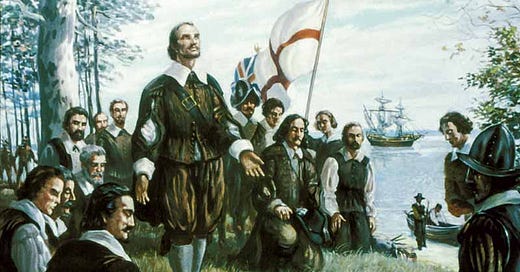As a new resident of the Commonwealth of Virginia, I am slowly learning about the history of this great state. From the earliest, and not-always-reliable works of Captain John Smith, such as A Map of Virginia (1612) to Thomas Jefferson’s Notes on the State of Virginia, and more “recent” works such as the 1940 Virginia: A Guide to the Old Dominion, by Writers’ Program of the Work Projects Administration in the State of Virginia, there is an almost inexhaustible amount of history to read. Pre-colonial, colonial, Revolutionary, Civil War, and onward, Virginia’s history is very much the American story (as the new VA license plates for the semiquincentennial note).
Organizations such as VA250 have been hosting numerous events throughout 2024 and will continue over the next two years, highlighting Virginia’s multifaceted role in the Revolution and after, while online resources like the Encyclopedia Virginia, a project of Virginia Humanities, offers a wealth of easily accessible information about the state’s past. And, I’m looking forward to visiting the Virginia Museum of History and Culture, in Richmond, just to get a grounding for appreciating all the other history sites throughout the Commonwealth. Perhaps only Massachusetts and New York can give Virginia a run for its money on historical sites per capita (I can already hear the criticism).
But, amidst my admittedly introductory knowledge about my new state, I only just stumbled across a staggering fact: America’s first Thanksgiving was held in Virginia, not in Massachusetts. This year marks the 405th anniversary of that first celebration.
(Modern representation of First Thanksgiving; image from Berkeley Plantation.)
Now, for anyone living in Virginia, they probably have known this, at least since 1958, when the Virginia Thanksgiving Festival was first held (it was opened to the public in 1962). I can only hope that all Virginia schoolchildren were, and still are, taught this fact in their early years. But for anyone not raised or resident in Virginia, I’ll bet few knew of the Commonwealth’s claim to Thanksgiving; I certainly didn’t.
The Washington Post wrote about Virginia’s Thanksgiving back in 2007, and the Washingtonian had a nice article in 2015. As Matt Blitz wrote in the Washingtonian:
On September 16th, 1619, the Margaret departed Bristol, England, bound for the New World. Aboard the 35-foot-long ship were 35 settlers, a crew, five “captain’s assistant”, a pilot, and [Captain John] Woodlief, a much-experienced survivor of the 1609/1610 Jamestown’s “Starving Time.” The mission of those aboard Margaret was to settle 8,000 acres of land along the James River that had been granted to them by the London-based Berkeley Company.
The Margaret reached the Chesapeake in late-November and dropped anchor at Berkeley Hundred (now Berkeley Plantation) on December 4, 1619. A good history of the First Thanksgiving on the Festival’s website recounts that once the contingent landed,
at a command from Captain Woodlief, with which they were profoundly stirred to comply, the homesick men knelt on the dried grass to pray.
As instructed by the London Company, Woodlief prayed: “We ordaine that this day of our ships arrival, at the place assigned for plantacon, in the land of Virginia, shall be yearly and perpetually kept holy as a day of Thanksgiving to Almighty God”.
The group celebrated with prayer and perhaps a modest meal, a far cry from the feasts of later days, and continued to do so in succeeding years. As the Festival history notes, “America’s first official English speaking Thanksgiving had just occurred, one year and 17 days before the Pilgrims landed in Massachusetts and almost 2 years before the pilgrims held a 3 day Harvest Feast with their Native American friends…” While it was the Pilgrims’ Thanksgiving that was to get all the attention from (largely New England) historians, one might also note that the first Plymouth Thanksgiving was neither a religious event nor a regular commemoration, unlike the Virginian version. Genealogy fans will get a kick out of learning that the history quoted above was written by Graham Woodlief, a direct descendant of John Woodlief and Washington-area resident, who was president of the Virginia Thanksgiving Festival.
Tragically, the Berkeley colony lasted only another three years, until being abandoned after a major attack by Powhatan Indians on several English colonies in the area on March 22, 1622, that resulted in the massacre of 347 settlers.
Incredibly, the history of the Berkeley Hundred was lost for over 300 years, until papers relating to the colony were discovered in 1931 by Professor Lyon G. Tyler, retired president of William & Mary College and son of former U.S. President John Tyler. Nearly three decades after that, in 1958, Berkeley Plantation owner Malcolm Jamieson invited members of the Woodlief Family back to the plantation to commemorate their ancestor’s achievement. In 1962, the Virginia Thanksgiving Festival was opened to the public, and is still going strong, on the first Sunday in November. Since I only found out about First Thanksgiving, I just missed this year’s festival, but I’m making plans to attend next year.
Meanwhile, on Thanksgiving, I’ll now be taking a moment to remember the adventurous souls of the Margaret, who crossed an ocean and gave their first thanks for deliverance. It was, of course, another Virginian, George Washington, who designated November 26, 1789, as “a day of public thanksgiving and prayer to be observed by acknowledging with grateful hearts the many signal favors of Almighty God, especially by affording them an opportunity peaceably to establish a form of government for their safety and happiness”—making today the 235th anniversary of that first Thanksgiving observance.




